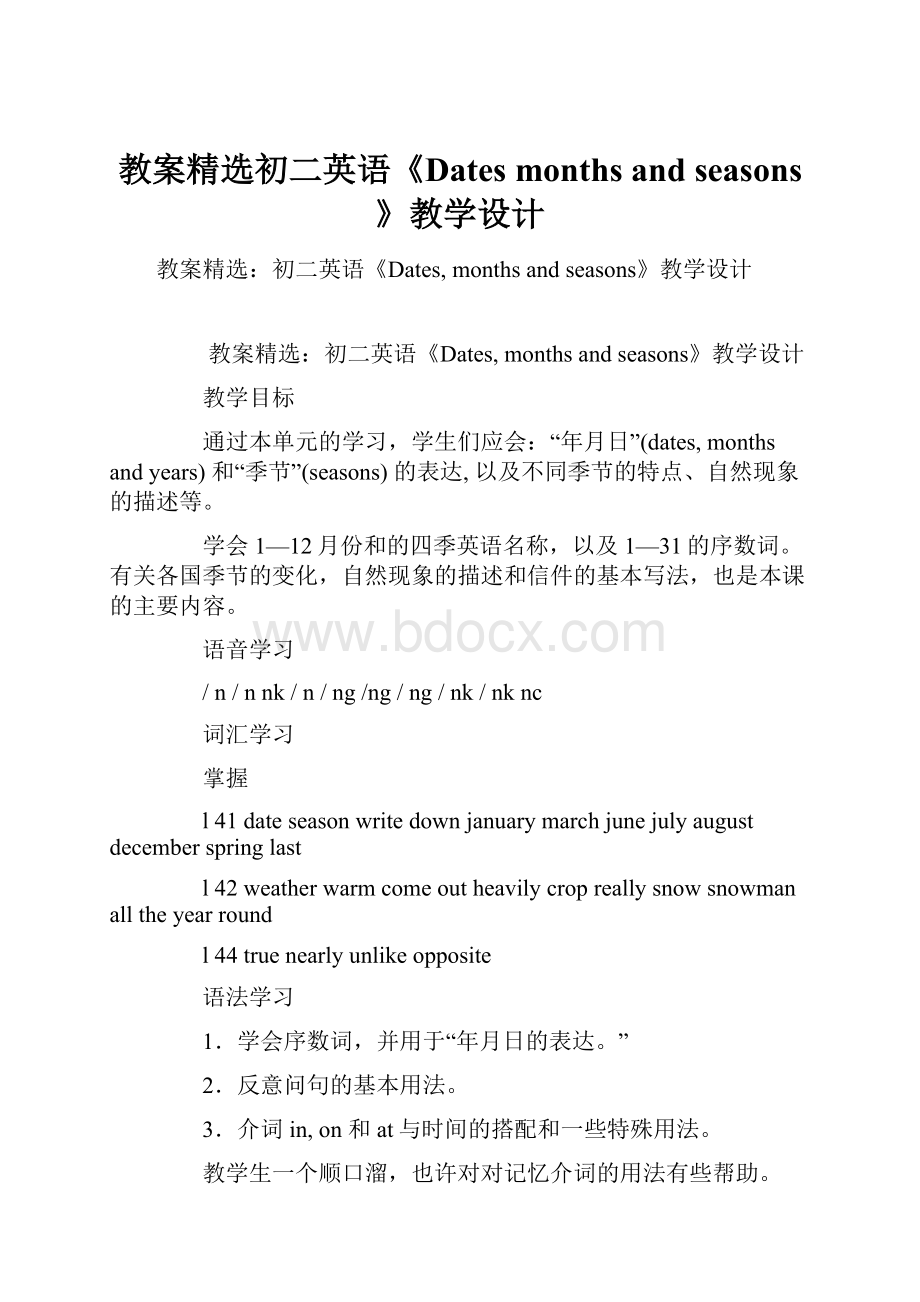教案精选初二英语《Dates months and seasons》教学设计.docx
《教案精选初二英语《Dates months and seasons》教学设计.docx》由会员分享,可在线阅读,更多相关《教案精选初二英语《Dates months and seasons》教学设计.docx(33页珍藏版)》请在冰豆网上搜索。

教案精选初二英语《Datesmonthsandseasons》教学设计
教案精选:
初二英语《Dates,monthsandseasons》教学设计
教案精选:
初二英语《Dates,monthsandseasons》教学设计
教学目标
通过本单元的学习,学生们应会:
“年月日”(dates,monthsandyears)和“季节”(seasons)的表达,以及不同季节的特点、自然现象的描述等。
学会1—12月份和的四季英语名称,以及1—31的序数词。
有关各国季节的变化,自然现象的描述和信件的基本写法,也是本课的主要内容。
语音学习
/n/nnk/n/ng/ng/ng/nk/nknc
词汇学习
掌握
l41dateseasonwritedownjanuarymarchjunejulyaugustdecemberspringlast
l42weatherwarmcomeoutheavilycropreallysnowsnowmanalltheyearround
l44truenearlyunlikeopposite
语法学习
1.学会序数词,并用于“年月日的表达。
”
2.反意问句的基本用法。
3.介词in,on和at与时间的搭配和一些特殊用法。
教学生一个顺口溜,也许对对记忆介词的用法有些帮助。
年用in月用in星期也用in
有年有月还用in
如果遇到年月日,千万记住要用on。
日常交际用语
whichisthesecond/fourth/monthoftheyear?
february/april.
whenisspring/summer/autumn/winter/inchina?
itlastsfrommarchtomay.
whatisthedatetoday?
it’sdecemberthe20th,2001.
what’stheweatherlikeinspring/summer/autumn/winterinyourhometown?
it’sverywarmandwindy.
thedaysgetwarmer,andthenightsgetlonger.
whichseasondoyoulikebest?
summer.
why?
becauseicanswimintheriver.
教学建议
本单元主要是围绕两个话题开展教学活动。
即“日期”和“季节”。
主要的语言项目是序数词,月份的名称和反意疑问句及回答。
在41课中,12个月份和四季的英语名称,1—31的序数词,一般现在时和一般过去时的有关日期的提问及回答都是比较难掌握的。
第42课是阅读课。
讲的是杭州的一中学生王伟给他的加拿大朋友的一封信。
信中描述了杭州的四季。
文章前的三个讨论题可让学生自由发挥,开展讨论。
第43颗主要是学会运用反意疑问句。
第三部分,看图说话可供条件极好的班级使用。
这一部分主要练习四季特征的描述。
可锻炼学生的语言组织能力和表达能力。
第44课为综合实践课。
提供了语音,听力,说话和阅读四个方面的材料。
其中说话部分要求学生真实地回答问题,复习了反意问句及有关问句,并给学生提供了自由发挥的空间。
阅读部分通过两个国家的气候对比叙述和文后的两幅图画,给学生们谈论气候提供了素材。
重难点分析
本单元的重点是学习并掌握反意疑问句的用法和介词in,on,at的用法。
难点是反意疑问句的两种不同形式及答语。
1.表示季节、月份、日期、天气状况的词,能很流利地运用这些词谈论季节和天气状况。
2.日期的提问和回答。
3.有关be动词和行为动词最基本的反意问句及回答。
4.介词in,on以及at和时间的搭配。
重点词组和短语分析
thanksb.forsth.为某事感谢某人
asksb.aboutsth.就某事询问某人
comeout(花)开;发(芽);出来;出现
rainheavily下大雨
abusyseason繁忙的季节
harvesttime收获季节
helpsb.withsth.在某事上帮助某人
workonthefarm在农场工作
makeasnowman做雪人
alltheyeararound一年四季
atthistimeoftheyear一年中的这个时候
inmuchofchina在中国的这个时候
lastfrom...to...从……延续到……
goonto...延续到……
warmclothes暖和的衣服
thebesttime最好的时节
日常交际分析
本单元的交际用语主要是关于天气状况和季节的,现将有关这两方面的词汇和句型总结如下:
1.词汇
1)spring,summer,autumn,winter
2)january,february,march,april,may,june,july,august,september,october,november,december
2.句型和短语
1)itis...inwinter/summer....
2)itis/lastsfrom...to....
3)goonto...
4)comeafter
5)it/theweatheris...,isn’tit?
6)atabadtimeofyear
7)atthistime/thattimeofyear
8)bedifferentfrom
9)what’stheweatherlike...?
词汇教学建议
以旧代新在学习12个月份的时候,先让学生复习已学过的几个月份。
用下面的表格引出以下新单词:
_____________february_____________
___april________may______________
________________________september_
__october__________________________
也可采用以四季划分的方式排列12个月份。
1.符合发音规律的单词
三月、六月和七月建议老师先让学生们仔细听三个单词的读音,推测出它们是什么字母。
必要时可写出音标。
相信学生们是可以拼出单词的。
也可写出单词,让学生自己读。
2.可用迁移的方法教单词
autumnaugustfebruaryjanuaryseptembernovemberdecember
3.教学生月份的简写
月份的简写一般是前三个字母。
如:
januaryjan.februaryfeb.
aprilapr.等。
用挂历让学生看月份的缩写。
语法教学建议
1.利用值日生报告学习日期的表达。
值日生报告制度是老师们常用的训练学生口语的方式。
此方法简单易行,深受老师和同学们的喜爱。
学习本单元大约在一月份,可利用这一段时间反复复习日期的表达。
重点是两类问题;whatdayisittoday?
whatdaywasyesterday?
和whatisthedatetoday?
whatwasthedateyesterday?
并以完全和缩略两种形式,把每天的日期都写在黑板上,如january20th,2003,jan.20th,2003,也可让值日生自己写,以加深学生们的印象。
2.利用常见句型,练习反意疑问句。
先让学生观察一些句子,老师可事先用投影写好一些句子,条件较好的班级也可由老师口头朗读这些句子,如:
it’sfinetoday,isn’tit?
yes,itis.
you’refromjapan,aren’tyou?
yes,iam.
让学生总结反意问句的构成,以及它的回答方式。
日常交际用语建议
1.让学生相互询问生日,朋友的生日、父母的生日、值日生报告等,练习年月日的表达。
教学完日期的表达方法后,应要求值日生每天进行这样的问答:
what’sthedatetoday?
whatwasthedateyesterday?
等。
这是复习巩固日期表达法的最好的途径。
2.通过编对话、描述等练习四季天气的表达。
可利用书上的彩图,教师平时要从画报上选择一些图片,做为补充。
这项工作也可发动学生帮助完成。
还可利用南北半球的气候差异做比较将会引起学生的兴趣。
指着中国和澳大利亚的地图让学生自己根据教材内容进行总结其差异及各自季节特点。
whichmonthisthecoldest/hottestinchina/australia?
canaustralianshavesnowonnewyear’sday?
反意疑问句
反意疑问句(thedisjunctivequestion)又叫附加疑问句,它表示提问的人对所提的事有一定的看法,但没有把握,需要对方来证实。
反意疑问句由两部分组成:
前一部分是一个陈述句,表示提问者的看法。
后一部分是一个简短的附加疑问句,对前部分陈述句中所陈述的内容提出疑问。
反意疑问句后半部分的附加疑问句应与前部分的陈述句在人称以及时态上保持一致。
反意疑问句的基本结构有以下两种:
1.陈述部分肯定式+疑问部分否定式?
2.陈述部分否定式+疑问部分肯定式?
例:
theyworkhard,don’tthey?
shewasillyesterday,wasn’tshe?
youdidn’tgo,didyou?
hecan’trideabike,canhe?
大多数反意疑问句的结构是和上面所说的一样,但也有些特殊的反意疑问句:
一、当陈述部分的主语是i,everyone,everything,nobody等词时,后面的附加疑问句一般这样来表示:
1.iamastudent,aren’ti?
2.everyoneisintheclassroom,aren’tthey?
3.everythingbeginstogrowinspring,doesn’tit?
4.nobodywillgo,willthey?
二、当陈述部分有never,seldom,hardly,few,little等含有否定意义的词语时,附加疑问句多用肯定式。
如:
1.hehasneverbeento(去过、到过)nanchang,hashe?
2.therearefewapplesinthebasket,arethere?
3.hecanhardlyswim,canhe?
4.theyseldomcomelate,dothey?
三、当陈述部分是ithink加宾语从句时,后面的附加疑问句应和宾语从句中的人称和时态保持一致。
如:
ithinkchickenscanswim,can’tthey?
ithinklucyisagoodgirl,isn’tshe?
四、当陈述部分有hadbetter时,附加疑问句应用hadn’t开头。
如:
you’dbettergetupearly,hadn’tyou?
五、当陈述部分是祈使句时,附加疑问句部分有不同的形式,并多使用肯定来表示有礼貌的请求。
如:
let’sgooutforawalk,shallwe?
注意:
letusgooutforawalk,willyou?
turnontheradio,willyou?
六、反意疑问句的回答用yes或no,但是当陈述部分是否定式,附加疑问句部分是肯定句时,答语中使用yes或no则应根据事实来决定,事实是肯定的用yes,事实是否定的就用no。
如:
theydon’tworkhard,dothey?
他们工作不太努力,是吗?
简略回答:
yes,theydo.不,他们工作努力。
no,theydon’t.是的,他们工作不努力。
另外,朗读反意疑问句时要注意:
前面的陈述部分通常用降调朗读,而后面的附加疑问句部分则要根据说话人的口气来定:
如果是很客气地要求对方回答,就用升调朗读,如果只表示一种语气上的强调,则用降调朗读。
分析in,on和at的用法
表示年、月、季节、星期等用in:
inayear/season/month/week/themorning/theafternoon/theevening/
theyhavefourclassesinthemorning,andtheyhavenoclassesintheafternoon.
表示日、日期、某一天的早晨、下午等用on:
onaday/date,onsunday/saturdayonwednesdaymorning,ontheeveningofmarch7th,2002
itrainedheavilyontheeveningofjune20th.
表示几点、某个时刻用at:
ateight/two/halfpastone/atthistimeyesterday/atthistimeofyear/atthattime/atpresent
hewaswatchingtvatthistimeyesterday.
零介词:
thisyear,lasttime,nextmonth,thenextday,alltheyearround,alltheday,thewholeday等。
theirfamilyaregoingtoflytolondonnextmonth.
at还有一些特殊的用法,如:
atwork,attable,athand,atonce,atlast,athome,atthesametime
atonce立刻
hisfathertelephonedhimtoreturnhomeatonce.
athand不远,快到
autumnisnearlyover.winterisathand.
atmost最多
helooksveryold,butinfactheisfortyatmost.
日期的表达与询问
日期表达
由于书写习惯的不同,英语里日期的写法也有差异。
美国人习惯先说日期后说月份,英国人则习惯先说月份后说日期,但年份均是放在最后。
书写日期时,可用阿拉伯数字表示,也可用序数词的缩略式(1st、2nd、4th)表示,但是年份只能用阿拉伯数字。
如1999年3月2日可表达为2(nd)march,1999(读作thesecondofmarch,nineteenninety-nine)或march2(nd),1999(读作marchthesecond,nineteenninety-nine)。
日期询问
1.几月几日的询问方法
a.what’sthedate(today)?
b.whatwasthedateyesterday(lastmonday…)?
其回答方式是:
it’s(itwas)…
2.星期几的询问方法
a.whatdayistoday(tomorrow)?
b.whatdayisittoday(tomorrow)?
c.whatdayoftheweekisittoday?
这种句子中可用today,tomorrow等名词作主语,也可用代词it作主语。
其回答方式是:
it’s(itwas)…
对话实例
a:
whatdayistoday?
b:
it’ssunday.
a:
whatwasthedateyesterday?
b:
itwasseptember10th,teachers’day.
lesson41教学设计方案
教学目标
学会12个月份、四季和顺数词的说法。
学会表达日期。
教学用具
投影仪、录影机以及挂历和媒体设备等。
教学步骤
step1revision
老师可先做dutyreport,除规定的内容外,必须让值日生回答以下几个问题:
whatdayisittoday/tomorrow?
whatdaywasityesterday?
whatisthedatetoday/tomorrow?
whatwasthedateyesterday?
然后将答案(完全形式和缩略形式)写在黑板上,并让学生视听,初步了解英文日期的表达与中文顺序的不同。
然后全班问学生几个问题:
whatdayisournationalday?
october1st./oct.1st.whichmonthisthespringfestivalin?
usuallyinfebruary.who/whosemother/whosefatherwasborninfebruary/april/may/september/october?
最好先找几个学生是在已学过的这几个月份出生的,或他们的父母是在这几个月份出生的,这样可先复习学过的几个月份。
按季节做以下表格。
先填出学过的季节和月份。
学完生词后填满表格。
step2presentation
learnandpractise
todaywe’llstudythefirstmonth,thethirdmonth,thesixthmonth,theseventhmonth,theeighthmonth,andtheeleventhmonthoftheyear.
以下单词符合发音规律,请同学们自己拼读,应该不会有太大的困难。
marchjunejuly
以下单词可迁移
autumnaugustfebruaryjanuaryseptembernovember,december
pastlastsingspringseaseason先让学生根据旧单词读出划线部分,然后再读整个单词。
这些单词大多数拼读较复杂,可让学生把这些单词先在本上抄一遍。
然后让学生练习自己的生日,每个人说出自己的生日。
可两人互相问答,练习说自己的生日,父母的生日,朋友的生日等。
最后教师问学生:
t:
howmanymonthsarethereinayear?
students:
therearetwelvemonthsinayear.
t:
whatarethey?
canyousaytheminenglish?
ss:
theyarejanuary,february,march,april,may,june,july,august,september,october,novemberanddecember.
让学生填满表格。
askandanswer
t:
therearefourseasonsinayear.theyarespring,slimmer,autumnandwinter.doyouknowwhenspring/summer/autumn/winterisinchina?
让学生根据上面填写的表格进行对话练习:
s1:
whenisspringinchina?
s2:
it’sfrommarchtomay.
s1:
whenissummerinchina?
s2:
it’sformjunetoaugust.
……
notes:
1.wesay“autumn”inbritain,andsay“fall”inamericanenglish.
2.whenwesayfourseasons,weshouldusepreposition“in”——inspring,insummer,inautumn/fall,inwinter.
3.preposition“on”
onmonday,ontuesday,onwednesday,onthursday,onfriday,onsaturday,onsunday
4.preposition“at”
at6oclock,at120clock,atthistimeofyear.
5.preposition“in”
inthemorning,intheafternoon,intheevening.
然后让学生自己完成课本上第2部分的练习。
learnandpractise
t:
doyourememberthecardinalnumbersthatwehavelearntbefore?
let’scountthemfromonetothirty-one.ok!
couldyoupleasewritethemdowninyournote-books?
whowantstowritethecardinalnumbersondueblackboard?
要一个学生来写下以前所学的数词:
one,two,three,four,five,six,seven,eight,nine,ten,eleven,twelve…twenty-one…thirtythirty-one
然后问这个学生是